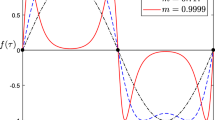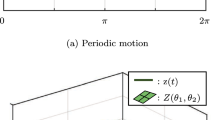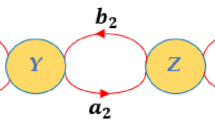Abstract
A new approach for forecasting and detecting emergencies by condition monitoring, based on the bifurcation analysis, is proposed using an experimental study of pulse energy conversion systems. The proposed approach uses online monitoring of “dangerous” bifurcation boundaries in a system parameter space. It enables it to identify “dangerous” bifurcation situations potentially associated with emergencies on-line, using systems state vector analysis. The approach is applied to a DC electric drive with energy pulse modulation. The results of the bifurcation analysis using mathematical and physical models as well as experimental evaluation testing the adequacy of the bifurcation analysis are discussed. This approach also has an application for the calculation of spare requirements.
Similar content being viewed by others
References
García, E.A. and P. M. Frank. “Deterministic non-linear observer-based approaches to fault diagnosis: a survey”. Control Engineering Practice, 5, no. 5 (1997) 663–670.
Haken, H. “Advanced synergetic. Instability hierarchies of self-organizing systems and devices”. Russian edition translated from 1983 Springer-Verlag edition, Moscow, Mir (1985)
Kolokolov, Yu.V, and S.L. Koschinsky. “The regularities of the development of the nonlinear dynamics of the control systems with pulse-width modulation”. Proc. of the ICNNAI’99, Brest, Belarus (1999).
Kolokolov, Yu.V. and S.L. Koschinsky. “On the bifurcation of stationary motions in impulse systems of automatic control”. Automation and Remote Control, 61, No 5, part. 2, (2000) 883–887.
Kolokolov, Yu.V., S.L. Koschinsky & K.H. Adjallah. “Experimental Study of the Adequacy of Bifurcation Approach to Emergencies Forecasting in Dynamics of Pulse Energy Conversion Systems”. Proc. of the “Maintenance and reliability conference (MARCON’2000)”, Knoxville, USA. (2000).
Nayfeh, A.H., A.M. Harb, C.-M. Chin, A.M.A. Hamdan and L. Mili. “Application of bifurcation theory to sub-synchronous resonance in power systems”. Int. J. Bifurcation and Chaos, 8, no. 1 (1998).
Patton, R. J. and J. Chen. “Observer-based fault detection and isolation: robustness and applications”. Control Engineering Practice 5, no. 5, (1997) 671–682.
Rao. B. K. N. Handbook of condition monitoring. Elsevier Advanced Technology, (1996).
Ueda Y., Ueda Y, Stewart H.B., Abraham R.H. “Nonlinear resonance in basin portraits of two coupled swings under periodic forcing”. Int. J. Bifurcation and Chaos, 8, no. 6, (1998) 1183–1197.
Author information
Authors and Affiliations
Rights and permissions
About this article
Cite this article
Kolokolov, Y.V., Koschinsky, S.L. & Adjallah, K.H. Bifurcation Approach to Condition Monitoring: Application to Pulse Energy Conversion Systems. OPSEARCH 39, 1–13 (2002). https://doi.org/10.1007/BF03398665
Published:
Issue Date:
DOI: https://doi.org/10.1007/BF03398665




